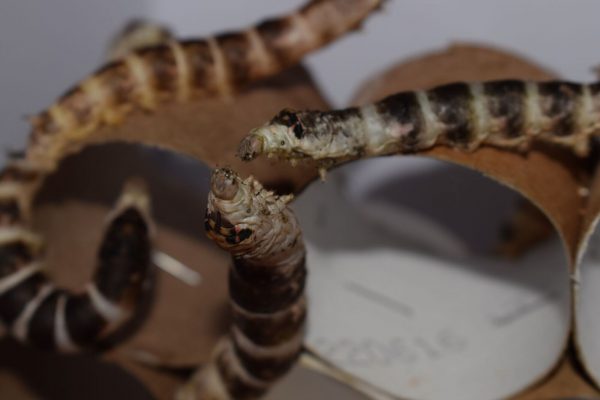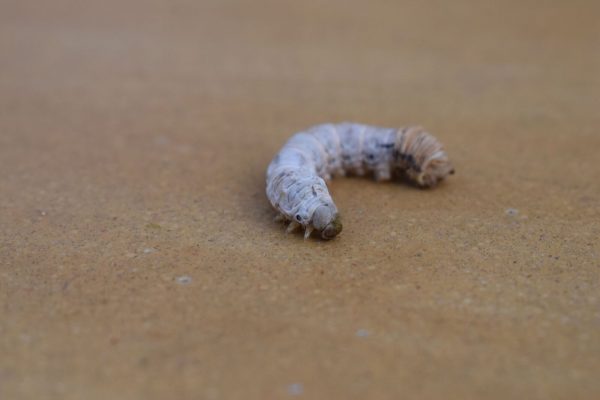How to Care for Silkworms
Housing
Before rearing Silkworms, it is important that you learn the correct way to care for them. Although it might be a little tedious at first, you’ll eventually get the knack of it, and slowly become an expert – learning little tricks after years of rearing!
After hatching, your new Silkworms will need care and attention for the next 20-35 days. The more that they are fed, the quicker they will hatch. Housing your new Silkworms should be easy. Small numbers (50-100) can easily be housed in shoe-boxes. Larger amounts, can be stored in trays.
As the Silkworms increase in size, make sure that you spread them out, so that they can live comfortably and with a decreased chance of contracting diseases. Silkworms – just like humans, are susceptible to diseases. So, make sure that you are removing their frass (droppings) each day. This process is referred to as “bed cleaning”.
Tip: On the bottom of your shoe-boxes, be sure to lay some paper or towel so that you can simply lift it out whenever a large amount of frass builds up.
Feeding
Extra attention must be paid when rearing smaller Silkworms. This is because smaller worms tend to get caught up in and amongst old leaves or frass. As a result, if no care is taken, you will find that you will not even end up with 50% of the number of cocoons as you did hatchlings.
There are a few simple strategies you can easily follow which will increase improve the mortality rate amongst your little Silkies:
- Ensure regular cleaning of the living area.
- Manually transfer the kegos (1st instar Silkworms) onto new food as opposed to just letting them crawl over.
- Begin rearing them on Silkworm Chow – before transferring their diet to Mulberry Leaves in the 2nd or 3rd instar.

Mulberry Leaves
Small Silkworms do not eat as much as older worms. Leaves should be added at least once per day. Ideally, give leaves two-three times per day when the Silkworms reach full size. Feed them once in the morning, once at midday, and once in the evening (if it’s a hot day and leaves wilt, swap them around more frequently). We suggest that – instead of feeding large amounts of leaves at once – increase the intervals at which you feed them, to reduce the build-up of waste and consequently reduce the chance of disease build-up.
If you do not want to transfer each Silkworm over when changing leaves you can place a piece of mesh over the box. Place the leaves on top, and the worms will crawl up through the mesh and onto the new leaves. After 25-30 days of looking after your Silkworms, they will start to eat more Mulberry Leaves than ever. Soon after, the Silkworms will be ready to start cocooning – reaching over x10,000 times their original weight!
Interesting Fact: In Spring, when the air temperature falls at night, Silkworms struggle to digest their food as a result. To counter this, many commercial farms tend to increase the quantity of feed in the mornings, as well as raising the temperature in the evening.

Silkworm Chow
Rearing Silkworms on Chow instead of Mulberry Leaves is becoming a more-and-more common option among Silkworm-rearers. The process of doing so is not marketably different. All you’ll need to do is mix the food upon its arrival, and store it in a fridge rather than picking leaves. Although Silkworm Chow is not as nutritious as feeding Silkworms Mulberry Leaves, it is a much more practical option. Mulberry Trees are quite hard to come by – especially in urban Australia.
It must also be noted that the difference in worms raised on Chow is not noticeable to many. The main difference comes from the quality of Silk produced – a factor that only those few raising Silkworms for the purpose of their Silk are concerned by.
If feeding chow to your Silkworms, we recommend that you feed them slices of the food – as opposed to a whole block. This allows for a greater surface area for your worms to feed on – reducing crowding in the feeding area and in turn the likelihood of an outbreak of disease. Upon your purchase of Silkworm Chow, you will be provided with further instructions as to how to best use the food source.

Storing your Silkworm Eggs
As a moth, your Silkworms will lay up to x500 little eggs. They will initially appear yellow, however after a few days, those eggs that are fertile will turn blue. These eggs however, will not be ready to hatch. In order to hatch, they will need to go through a cold period first. In nature, this cold period is Winter – however as you can raise Silkworms at any stage of the year these days – thanks to Silkworm Chow and heating – Winter may not necessarily be around the corner! To simulate this, place your eggs in a fridge (for at least 3 months, and no longer than a year). After this time period, your eggs will be ready to hatch!
Note: Once eggs have been refrigerated – and taken out – you can not put them back in the fridge – as they will already have begun their process of hatching – and this will kill them.
The best time to begin rearing Silkworms is after the start of Spring, or check when your Mulberry Tree has begun to sprout.

For more rearing tips, and to better understand how to care for your Silkworms, make sure to join our online rearing community here.




